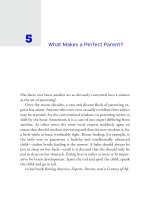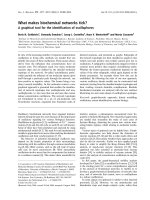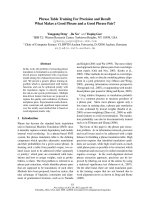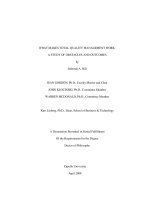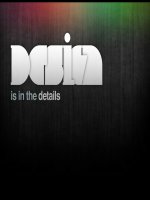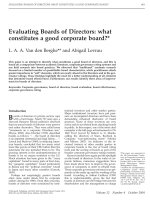What makes a good android application
Bạn đang xem bản rút gọn của tài liệu. Xem và tải ngay bản đầy đủ của tài liệu tại đây (101.82 KB, 5 trang )
Rubric
What makes a good Android smartphone application?
Throughout the course we will be referring to the following rubric to evaluate the project milestones up to the final project deliverable. The rubric will
help you identify what makes a project more or less successful, and why. It will help you to self-assess your own work and enable your peers to
provide you more constructive feedback.
Don't worry if some criteria are unclear for now, you will gain understanding and familiarize with them as you progress through the course.
levels of mastery ►
dimensions/criteria ▼
1.1
1.2
1.3
workflow, navigation within
the application
doesn't meet expectation / below
proficient / needs improvements
unnatural, confusing, inconsistent
meets expectation / proficient
natural, easy to grasp
exceeds expectation / above
proficient / sophisticated /
exemplary
in addition: contextual help, help
menu, hints in text input areas
requires a lot of user's actions to get the most common/frequent path in the path most frequently chosen by
to a particular, frequently used point the application workflow requires as the user gets associated with a shortfew clicks/actions as possible
cut
for instance, the most frequent
action is to add an item from the
toddler toys department into the
shopping cart, but the user needs to
click “add item”, then “chose dpt”,
then “toys”, then “toddlers”
for instance, there are a “add item
from toddler toys dpt.” and a “add
item from other dpt.” buttons, the
second button leading to the choice
of dpt.
provides no feedback to confirm to
the user his commands have been
interpreted
lets the user know if his actions
where successful or not
for instance, if unlike other persons
the user visits the “music dpt.” more
often than the “toddler toys dpt.”,
the short-cut button will be
customized to link to the music dpt.
Instead
for instance, uses pop-up messages,
bip or buzz sounds
1.4
obscure or easy to miss error
error messages are clearly visible
the application tries to fix the
1.5
messages
and explain what is wrong and how problem for the user
the user can fix the problem
for instance: “bad name”,
written in the same color as the the
user input
for instance: “bad name: names
for instance: if the user types “jOhn”
start with a capital letter and
for his name, the application
contain only letters and single quote proposes to replace by “John”
character”,
written in red under the problematic
text area
the same information is asked twice information is transfered from on
part of the application to the next
and not asked twice
for instance, the user is asked for
his zip code when he wants to find
the closest shop and he is asked
again in another page when he
places an order
1.6
2
whenever possible, the application
“guesses” informations to avoid that
the user types them
for instance, when the user is asked for instance, if the user provided his
to provide an address to process his city, look up the zip code in a data
order, the zip code field is
base instead of asking it to the user
automatically filled using
information provided in a previous
page
perform destructive actions without displays confirmation dialog before in addition: provide a way to restore
asking confirmation
performing important actions (such deleted data
as deleting all data, or placing a
shopping order)
respect of GUI standard
practices
does not respect standard GUI
conforms to standard GUI practices in addition: adapt to user's country
usages
for instance:
for instance:
- vertical scrollbars are located on - vertical scrollbars are located on
the left side
the right side
- confirmation button is called
- confirmation button is called
“affirm” (and pairs with “annul”) “OK” (and pairs with “cancel”)
- has components that look like GUI - colored or underlined text is a
controls but aren't:
clickable link
- colored or underlined text is
- buttons initiate actions
not a clickable link
- something looks like a button but
doesn't initiate an action
- something looks like a radio
button but isn't a choice
3
accessibility
- color choices or font sizes don't
- reasonable font size and contrast
allow for good readability
- at least 57 px wide X 45 px heigh
- clickable areas are too small or to clickable areas
close to each others to allow precise
clicking without zooming in
in addition: option to allow the user
to configure colors and fonts
4
layout
does not adapt well to some display adapt to different display sizes
size
in addition: adapt to both portrait and
landscape orientation
for instance, there is no scrollbar to
reach a button at the bottom
5
data input
- the user needs to enter data letter
by letter or digit by digit at each run
- display the default a-z soft
keyboard when the user clicks an
EditText supposed to start with a
number
- provides automatic completion or
lists of pre-entered data to chose
from
- provides default values
6
pauses or interruptions
handling
not considered:
when incoming call is picked up,
- when incoming call is picked up or music pauses and data is saved
the back button is hit, music keeps
playing, or data is not saved
- phone rotation gives uncontrolled
results
in addition: phone rotation is handled
gracefully: the user does not restart
from a fresh screen with empty
EditText or unchecked radio buttons,
instead the screen displays the same
information as before the rotation
7
bug
insufficiently tested, there are bugs
which cause the application to stop
even with valid user inputs
user inputs are checked for
correctness
no bug under normal condition
(valid user inputs)
in addition:
- save and propose previously entered
data
- display the appropriate soft
keyboard depending on the expected
kind of input
for instance, the date Feb. 29th, 2015
will be detected as non valid and the
user will be asked to correct it
8
code maintainability, ease of - non or poorly indented code
future evolution by a different - no comment in the code
developer
- obscure names for methods,
activities or objects...
- code is indented according to
conventions
- code is commented
- objects have meaningful names/ids
9
performances (not covered in the app wastes battery power, or
this course)
storage space, or is not responsive
enough
the app is careful with power and
storage resources and with
responsiveness
for instance:
- it makes a lot of useless
computations
- it requests localization in all its
activities even though it is only
really necessary in a particular one
- operations which take a while to
complete freeze the user interface
until they are accomplished
10
in addition: external documentation
with mockups, flowmap and textual
descriptions, classes and sequence
diagrams, tests suite
for instance:
- it lets the user remove some stored
information (for instance the user
can decide to delete the profile
picture he provided at first)
- time-consuming operations (such
as network transfers) are performed
in the background and the GUI
keeps responsive
security (not covered in this
course)
Additional resources:
Material Design: Google's Guidelines to design for Android devices: />
A Checklist for Designing Mobile Input Fields: />
Bruce Tognazzini's First Principles of Interaction Design: />
Finger-Friendly Design: Ideal Mobile Touchscreen Target Sizes: />
